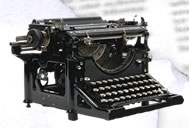Attached are pictured six straw hats from a 1941 color ad promoting the Stetson Straws that appeared on the glossy pages of one of the more bourgeois American magazines just seven and a half months prior to the day when the bombs fell on Pearl Harbor and the bad-old days of World War II kicked-in for that rare breed of man known as homo-Americanus.
There can be no doubt that the fun-loving fashion-fan who was pictured sporting these organic chapeaus would soon find himself wearing one of Uncle Sam's over-laundered denim stitch-brims, peeling potatoes and remembering wistfully the day that this ad was shot.
We hope he survived the carnage.
This article appeared in an issue
Click Magazine that was deliberately edited to aid those young men who had been wearing uniforms for the past few years and, subsequently, had no knowledge whatever of tailoring or of fabric that was not government issued. It consists of a handy guide for the aspiring dandy showing just how a gentleman's suit should fit if it is to be properly worn.
Read an article about the history of Brooks Brothers
A chart produced by the editors of MEN'S WEAR MAGAZINE indicating the best-selling colored wool used in men's suits spanning the years 1935 through 1950.
The pointy-headed soothsayers who attempt to predict which colors men would buy were very surprised to find that in the aftermath of World War II, American men were quite eager to buy browns and khaki-colored suiting after all.
The attached 1945 article was intended to serve as a suit-buying-guide for all those young men who were in the throes of trading in their military uniforms for civilian attire.
The one kind of wool that is not discussed in this article is "worsted": this was the wool that was specifically reserved for the uniforms of the U.S. military (enough to outfit 12 million souls) and there wasn't a single thread of it that could be purchased on the civilian market.
One evening in 1947, Henry L. Jackson, co-founder of
Esquire Magazine, realized that his magazine alone was not sufficient enough in circulation for passing the word along to his fellows that the rules for
men's evening wear were rapidly being rewritten; knowing full-well that
Collier's was one of the preeminent American magazines of its day, he no-doubt must have pleaded the urgency of his case to their editors and, in so doing, saved the collective faces of the homo Americanus once more! We're delighted that he did so, because now you will have a more thorough understanding as to how you might have dressed had you lived in post-war America.
If you've been wondering what the stylish Yankee beaus of yore used to wear during the Summer of 1941 when they plopped themselves down to read about the British occupation of Syria or the Nazi siege of Leningrad, then you can stop looking because we have the article right here - it is the summer fashion forecast from COLLIER'S MAGAZINE of May 24, 1941 - illustrated with no fewer than three color images:
"The newest color for vacation clothes is parchment, one of the natural tan shades. Don't be afraid that you'll look like a member of the street-cleaning department in a white linen suit. Even the Duke of Windsor wears one. It is ideal for vacation wear, as the jacket may be worn with colored slacks, the trousers with other light weight jackets.... For week-end and vacation wear you can choose from tropical worsteds, Palm Beach cloth, tropical weight flannels, linen, seersucker and tropical weight tweeds."
With her characteristic disregard for the unreasonable mandates of the prevailing fashion police hanging out for all to see, Elizabeth Hawes (1903 – 1971) scoffed with the deepest irreverence at the males of the species for being so thoughtless and blind in matters sartorial. Pointing out that men, who she compared to mice, don't have to wear ties, hats, heavy leather shoes or anything else that makes them uncomfortable, but do so purposelessly and out of fear...
Click here to read a 1929 article about the Dress-Reform Movement.
In light of the fact that all Army personnel would be issued $300 with their honorable discharge papers, the fashion editor for Esquire Magazine, Henry Jackson, decided to moonlight at Collier's in order to provide some solid fashion-tips on how best to spend that hard-earned cash.
Fashion writer Henry Jackson had a few words to say concerning the importance of Glen Plaid in men's fashions during the Fall of 1940.
This article heralds the slippery slope in men's fashion. Our's is the era in which it is not odd to see billion-dollar businesses being run by men in flipflops and gym shorts - this is a far cry from how their grandfathers would have dressed were they in the same position. The well-respected fashion journalist (Henry L. Jackson, 1911 - 1948: co-founder of Esquire)
opined in this article that it was suitable for men to cease wearing the darker hues to the office and wear country tweeds; next stop - flipflops.
